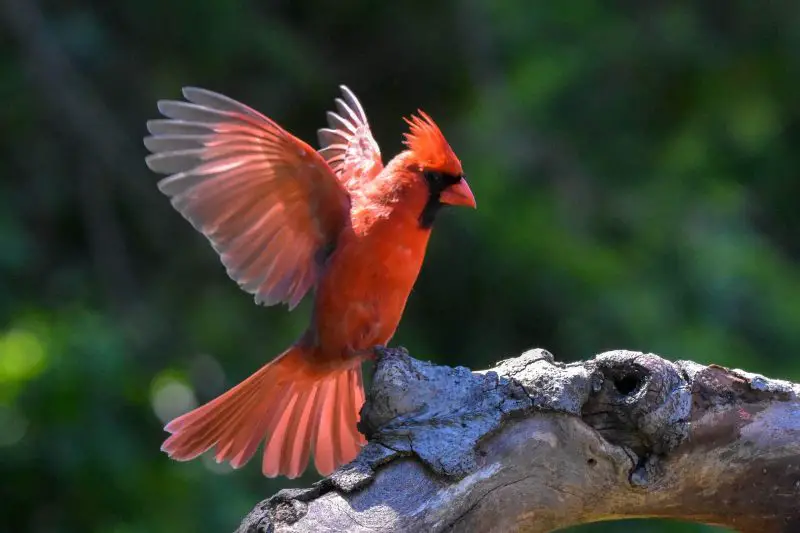Northern Cardinals thrive across North Carolina’s varied habitats, from misty Appalachian woodlands to the humid coastal plain. Their deep red plumage, distinct crests, and sharp vocal patterns make them one of the most recognizable songbirds in the eastern United States. Yet beneath this familiar appearance lies a set of behaviors, instincts, and ecological roles that many people never notice. Cardinals are far more than backyard visitors—they are complex, territorial, and deeply attuned to the landscapes they inhabit.
North Carolina’s mixed forests, suburban corridors, and broad river basins create ideal conditions for cardinals. Dense understory vegetation, mild winters, and abundant year-round food sources allow these birds to express behaviors that are often suppressed or harder to observe elsewhere. Their territorial rituals, subtle communication signals, and seasonal patterns become especially clear in this environment.
This article explores the hidden world of Northern Cardinals in North Carolina, revealing their foraging strategies, nesting habits, seasonal rhythms, territorial intelligence, and interactions with other wildlife. These insights reveal a bird whose life is deeply shaped by the ecosystems of the state—and whose behaviors offer clues about the health and structure of North Carolina’s natural landscapes.
Understanding Northern Cardinals in North Carolina

What Northern Cardinals Truly Are
Northern Cardinals are medium-sized songbirds known for their crests, thick conical bills, and sexually dimorphic coloration. Males are striking red, with black facial masks that accentuate their plumage, while females exhibit warm tan and soft reddish tones that blend seamlessly into woodland edges. Although commonly associated with backyard feeders, cardinals are primarily forest-edge specialists, adapted to habitats with dense shrub layers and semi-open understory.
Their short, powerful bills are designed for cracking seeds, but they are equally efficient for catching insects. This dual feeding adaptation allows cardinals to persist through seasonal changes and exploit a wide range of food resources. Their calls—which range from sharp metallic chips to long, whistled sequences—carry through forests and neighborhoods, helping establish territory and coordinate with mates.
Northern Cardinals are non-migratory, meaning they remain in North Carolina throughout all seasons. This residency shapes nearly every aspect of their behavior, especially territory defense and pair bonding. Their year-round presence makes them a consistent indicator of habitat stability.
Why North Carolina Provides Ideal Habitat
North Carolina’s ecological diversity benefits cardinals enormously. In the Piedmont, a mix of hardwood forests, hedgerows, and suburban gardens offers food and shelter. In the Coastal Plain, dense thickets of yaupon, wax myrtle, and holly provide nesting cover. In the mountains, layered canopies and rhododendron understories create microhabitats with abundant insects and protective shrub layers.
Mild winters allow cardinals to maintain territories without migrating, while the long growing season supports multiple broods each year. Native berry-producing shrubs—such as dogwood, viburnum, elderberry, and spicebush—supply energy-rich foods that sustain birds through late fall and winter.
The state’s blend of natural and human-shaped environments creates a mosaic of suitable territories, enabling cardinals to thrive in rural, suburban, and semi-urban regions alike.
Where Cardinals Occur Across the State
Northern Cardinals are widespread in North Carolina and appear in nearly every county. They inhabit forest borders, river floodplains, pine-hardwood mixes, farm edges, backyard gardens, and even city parks with abundant shrub layers. Populations are densest where thick underbrush and berry-producing shrubs are common, especially in the Piedmont and Coastal Plain.
Along mountain foothills, cardinals occupy lower elevations and moderate slopes. In coastal regions, they thrive in maritime forests, shrub thickets, and residential landscapes. Their adaptability ensures a strong presence even in areas with heavy human development.
Hidden Behaviors Most People Never Notice
Their Year-Round Territorial System
One of the most surprising aspects of Northern Cardinal behavior is their year-round territoriality. Many songbirds defend territories only during breeding season, but cardinals maintain boundaries throughout the entire year. This constant vigilance allows them to secure reliable food sources and nesting areas.
Males and females both participate in territory defense. Their sharp “chip” calls act as alarm signals and boundary markers. These notes vary subtly in pitch and intensity, allowing cardinals to convey urgency, distance, and direction. Birdwatchers who listen closely can often interpret these signals.
In winter months, territorial boundaries become more relaxed, but pairs still patrol core areas around food sources. Their ability to manage territory continuously highlights cognitive skills rarely associated with backyard birds.
Their Subtle Pair Communication
Cardinals exhibit one of the richest communication systems of any North American songbird. Beyond their well-known whistled songs, they use quiet contact calls, wing flicks, posture shifts, and subtle tail angles to convey information.
Pairs often engage in duets—males and females exchanging phrases in coordinated patterns. These interactions help maintain pair bonds, synchronize breeding behaviors, and reinforce territory ownership.
During nesting, females adjust call patterns to guide males to food-rich foraging zones. Males respond with rapid chip sequences when predators approach the nest. This whispered communication network operates constantly, hidden beneath everyday backyard activity.
Their Ground-Foraging Intelligence
Although cardinals often visit feeders, much of their natural foraging occurs on or near the ground. They use a precise scanning technique—tilting the head slightly and examining leaf litter for seeds, beetles, ants, and other small invertebrates.
Cardinals are selective feeders, able to distinguish seed density and insect movement by subtle shifts in vegetation. Their thick bills crack seeds efficiently, while their dexterity allows them to pluck insects from bark and foliage during warmer months.
This combination of seed-foraging and insect-hunting allows them to adjust diets dynamically based on seasonal availability.
Anatomy and Adaptations for North Carolina Environments
Plumage Built for Both Display and Survival
Male cardinals’ vibrant red feathers function as both display and deterrent. Bright coloration signals fitness to rivals and females, but it also carries risks by increasing visibility to predators. Males counter this by relying on dense cover for rapid retreat.
Females possess softer, earth-toned plumage that provides camouflage during nesting. Their coloration blends into pine needles, leaf mats, and shrub layers—an essential adaptation for protecting eggs and chicks.
Seasonal molt cycles refresh plumage, and diet influences coloration intensity. Berries rich in carotenoids contribute to deeper reds in males, especially late in summer.
Bills Shaped for Versatile Diets
Cardinals’ thick, conical bills crack seeds with ease, but their internal structure allows for precise insect handling as well. Their bite force enables them to consume tough seeds many other birds cannot access.
During chick-rearing, they shift diet heavily toward insects, using their bills to capture beetles, spiders, and caterpillars. This versatility supports survival across diverse habitats.
Strong Legs for Territorial Display and Foraging
Cardinals spend much of their time hopping through shrubs and along the ground. Their strong legs support rapid bursts of movement when predators approach and allow efficient foraging among leaf litter.
During territorial disputes, males employ upright postures and forward-leaning stances that rely heavily on leg strength for balance and display.
Feeding Habits Across North Carolina
Seasonal Diet Patterns
Cardinals consume seeds, berries, insects, and small fruits throughout the year. Their diet shifts seasonally:
• Spring: Insects dominate as breeding begins. Protein supports egg formation and chick growth.
• Summer: Fruits from dogwoods, mulberries, and blackberries supply hydration and pigmentation.
• Fall: Seeds and late-season berries provide energy reserves.
• Winter: High-fat seeds—especially sunflower seeds—become essential.
Their ability to exploit multiple food sources stabilizes populations throughout all regions of the state.
Foraging in Native Habitats
Cardinals forage heavily in mixed pine-hardwood forests, using understory shrubs as both feeding platforms and protective cover. They pick seeds from herbaceous plants and search leaf litter for beetles and ants.
In creekside habitats, they consume small fruits and search for insects along exposed roots and mudbanks. Woodland edges offer some of the richest feeding zones, with dense vegetation sheltering numerous prey species.
Use of Human-Altered Landscapes
Cardinals adapt remarkably well to suburban developments. They take advantage of bird feeders, ornamental berry plants, and trimmed hedges that mimic natural shrub structure.
Lawns with scattered shrubs provide predictable routes and safety corridors. Even city parks support cardinal populations where dense underbrush is preserved.
Their ability to exploit exposed food sources while relying on nearby cover makes them well suited for human-dominated areas.
Nesting and Breeding Behavior
Grounded in Dense Shrub Layers
Cardinals typically nest in dense shrubs, vines, and low trees—areas that offer concealment from predators. Nests sit several feet above ground, hidden in tangles of honeysuckle, blackberry thickets, or evergreen foliage.
Females construct the nest using grasses, bark strips, and rootlets, forming a deep cup lined with soft materials. This structure withstands spring storms and summer heat.
The preference for low, concealed nests reflects their adaptation to North Carolina’s abundant underbrush.
Raising Chicks in a Changing Environment
Females incubate eggs while males provide food and maintain territory. Chicks hatch blind and featherless, requiring constant feeding. Parents deliver insects frequently to accelerate growth.
Within a week, chicks grow rapidly, developing down and gaining the strength to vocalize. After fledging, they remain close to parents for several weeks, learning feeding routes and call patterns.
Multiple Broods Each Year
North Carolina’s long warm season allows cardinals to raise two or even three broods. Spring rains and summer insect flushes create ideal conditions for extended breeding activity.
Pairs often reuse parts of old nests or build new structures close to established routes.
Cardinals Across North Carolina Landscapes
Mountain Piedmont Transition Zones
Along the foothills of the Appalachians, cardinals occupy forest edges and rhododendron understories. These regions offer rich insect communities and sheltered nesting sites.
Piedmont Woodlands and Suburbs
The Piedmont supports some of the highest cardinal densities in the state. Mixed forests, hedgerows, and suburban neighborhoods create mosaic-like habitats ideal for foraging and nesting.
Coastal Plain Shrublands
Maritime forests, wax myrtle thickets, and river swamp edges provide abundant fruit sources. The mild coastal climate allows exceptionally early breeding in some years.
Agricultural and Semi-Open Areas
Fields, pasture edges, and fencerows offer seed-rich feeding grounds. Cardinals use scattered shrubs for cover while foraging in open zones.
Seasonal Rhythms of North Carolina Cardinals
Winter
Cardinals remain highly active during winter. Their bright plumage contrasts sharply with dormant landscapes, and they rely heavily on seeds and evergreen thickets for survival.
Spring
Spring brings a surge of song as males defend territories. Courtship intensifies, and pairs select nest sites quickly. Insect availability increases, supporting early broods.
Summer
Summer is peak breeding season. Chicks develop rapidly, and adults shift diet toward fruit-rich foods. Heat drives activity into early mornings and late afternoons.
Autumn
As temperatures drop, cardinals begin establishing winter territories. They build fat reserves by consuming late-season berries and seeds.
Interaction With Other Wildlife
Birds
Cardinals share habitats with chickadees, wrens, sparrows, and woodpeckers. Competition remains minimal because species utilize different foraging levels and food types.
Mammals
Squirrels, raccoons, foxes, and domestic cats present the greatest threats. Cardinals depend on dense cover for escape.
Insects
Insects are critical during nesting season. Cardinals play a significant role in regulating beetle and caterpillar populations.
Myths and Misconceptions
Myth: Male cardinals stay bright red all year
Color varies with molt, diet, and sun exposure. Late-summer males often appear patchy or dull.
Myth: Cardinals only sing in spring
Both sexes vocalize year round for territory, communication, and alerting mates.
Myth: Cardinals only live in forests
They thrive in suburbs, farmlands, and mixed landscapes—anywhere dense shrubs and food are available.
Ecological Importance
Seed Regulation
Cardinals consume large quantities of seeds, helping shape understory plant communities.
Insect Population Control
Their heavy insect consumption during breeding helps reduce pest pressure on native plants.
Ecosystem Health Indicators
Strong cardinal populations indicate healthy shrub layers and balanced forest-edge ecosystems.
FAQs About Northern Cardinals in North Carolina
Are cardinals year-round residents?
Yes. They remain in North Carolina through all seasons.
What do they eat?
Seeds, berries, insects, and fruits depending on the time of year.
Are they good for backyards?
Yes. They help control insects and disperse seeds.
Why do some cardinals look brownish?
Molt cycles and diet can cause temporary color changes.
Conclusion
Northern Cardinals in North Carolina are more than familiar backyard birds—they are dynamic, intelligent, and highly adapted to the state’s layered environments. Their hidden communication systems, territorial intelligence, feeding versatility, and seasonal rhythms reveal a species deeply intertwined with every region of North Carolina. By learning how these birds navigate forests, suburbs, and coastal habitats, we gain insight into the ecological health of the state itself and develop a deeper appreciation for one of its most charismatic residents.






